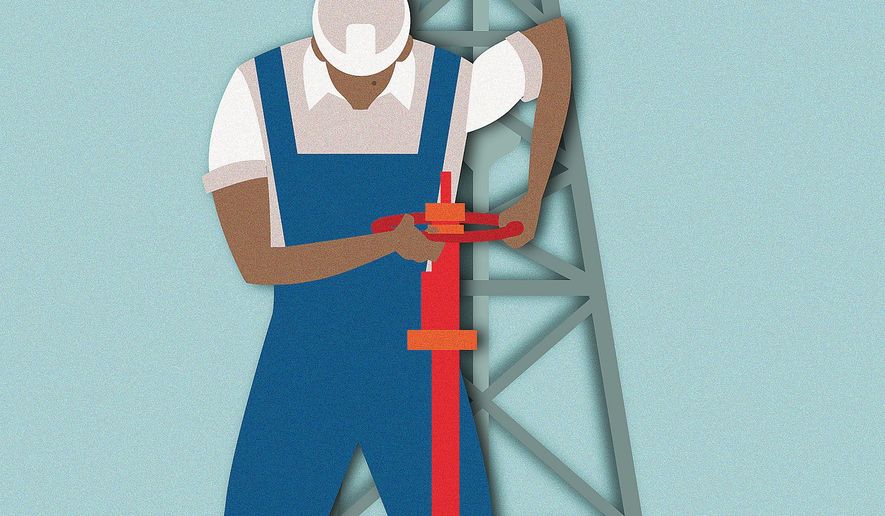OPINION:
“That whole — suddenly America’s like the biggest oil producer and the biggest gas — that was me, people.”
So said former President Barack Obama at a recent event in Houston. It’s not surprising that any president would want to take credit for America’s resurgence as an energy superpower: It has unequivocally transformed our economy for the better, from reducing energy prices for consumers to enhancing our national security. It has even helped the United States lead the world in reducing emissions of carbon dioxide.
But was Mr. Obama correct? As ESPN’s Lee Corso might say, “Not so fast, my friend.”
According to a recent report from the Congressional Research Service, during Mr. Obama’s eight years in office (2009-16), U.S. oil and natural gas production did indeed surge. In 2009, U.S. oil production was 5.3 million barrels per day. Total production in 2016 averaged 8.8 million barrels per day, a 66 percent increase. Natural gas production also increased from nearly 26 trillion cubic feet in 2009 to more than 32 trillion cubic feet in 2016.
But total production isn’t necessarily the best measurement. States have traditionally taken the lead in regulating oil and gas within their borders, which means production on state and private lands is more a product of state, not federal, regulation.
The president, meanwhile, has more control over production on federal lands, both onshore and offshore. In 2009 the United States produced approximately 282,000 barrels of oil per day on federal onshore acreage, and in 2016 that number had risen to 475,000 barrels per day a significant increase percentage wise, but small overall compared to total production of 8.8 million barrels per day in 2016. Onshore natural gas production on federal lands declined about 18 percent over the same period, from 4 trillion cubic feet to 3.3 trillion cubic feet.
Offshore, oil production was slightly lower in 2016 than it was in 2009, and natural gas production declined by approximately 1.2 billion cubic feet. Offshore oil production took a substantial hit for several years after 2010 even while production was increasing elsewhere after Mr. Obama imposed a costly offshore drilling moratorium in the wake of the Deepwater Horizon incident.
Meanwhile, on state and private lands, the shale revolution has completely transformed America’s energy future.
From 2009 through 2016, oil production on state and private lands more than doubled from 3.4 million barrels per day to 7.1 million barrels per day. Natural gas production increased by almost 9 trillion cubic feet.
In 2009, production on federal lands (offshore and onshore) accounted for approximately 36 percent of all U.S. oil production, but by the end of 2016, that number had fallen to just 24 percent. For U.S. natural gas production, 25 percent of it was on federal lands in 2009, but in 2016 it was just 14 percent.
The oil and gas production over which Mr. Obama’s administration had the most control was a smaller portion of the U.S. total when he left office than when he was inaugurated.
Additionally, Mr. Obama imposed several controversial regulations that restricted new development, including everything from methane rules to tightening the air quality standard for ozone. He asserted that more U.S. drilling would not bring down gasoline prices, a claim that has since been disproven. His annual budgetary threat to raise taxes on oil and gas producers may have been political bluster, but it certainly wasn’t creating a more conducive environment for investment.
Yet while the anti-drilling Gasland films were being treated in the press as legitimate documentaries, and “Keep It In the Ground” groups like the Sierra Club were flip-flopping on the benefits of natural gas, it would have been easy for Mr. Obama to cater to the environmentalist fringe and endorse their policies. Instead, he touted shale in one of his State of the Union addresses, referenced the consumer benefits of low-cost natural gas and ensured that the radical “ban fracking now” movement remained a noisy but largely marginalized phenomenon, which is where it remains today.
For that, Mr. Obama deserves some credit. His regulatory control over state and private lands may have been limited, but he could have easily given local officials the political cover necessary to adopt extreme measures that would have further restricted production.
America’s rise as a global energy superpower has largely been a function of innovation and investment on state and private lands. The fact that no president — Republican or Democrat — has much control over it is arguably why it happened in the first place.
• Steve Everley is spokesman for Texans for Natural Gas.




Please read our comment policy before commenting.